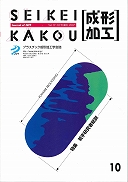All issues

Volume 19, Issue 10
Displaying 1-16 of 16 articles from this issue
- |<
- <
- 1
- >
- >|
Index
-
2007 Volume 19 Issue 10 Pages Index10_1-Index10_2
Published: October 20, 2007
Released on J-STAGE: February 25, 2021
JOURNAL FREE ACCESSDownload PDF (571K)
Preface
-
Takeshi Kikutani2007 Volume 19 Issue 10 Pages 599
Published: October 20, 2007
Released on J-STAGE: February 25, 2021
JOURNAL FREE ACCESSDownload PDF (603K)
Technical Notes : Special Issue on Review Articles by Rising Researchers
-
Tatsuya Kawaguchi2007 Volume 19 Issue 10 Pages 600-605
Published: October 20, 2007
Released on J-STAGE: February 25, 2021
JOURNAL FREE ACCESSDownload PDF (1551K) -
Daisuke Sawai2007 Volume 19 Issue 10 Pages 606-612
Published: October 20, 2007
Released on J-STAGE: February 25, 2021
JOURNAL FREE ACCESSDownload PDF (1081K) -
Kenji Furuichi2007 Volume 19 Issue 10 Pages 613-617
Published: October 20, 2007
Released on J-STAGE: February 25, 2021
JOURNAL FREE ACCESSDownload PDF (947K) -
Masaya Kotaki2007 Volume 19 Issue 10 Pages 618-622
Published: October 20, 2007
Released on J-STAGE: February 25, 2021
JOURNAL FREE ACCESSDownload PDF (8587K) -
Masataka Sugimoto2007 Volume 19 Issue 10 Pages 623-628
Published: October 20, 2007
Released on J-STAGE: February 25, 2021
JOURNAL FREE ACCESSDownload PDF (11027K) -
Akihiro Nishioka2007 Volume 19 Issue 10 Pages 629-633
Published: October 20, 2007
Released on J-STAGE: February 25, 2021
JOURNAL FREE ACCESSDownload PDF (7449K) -
Hajime Kimura2007 Volume 19 Issue 10 Pages 634-640
Published: October 20, 2007
Released on J-STAGE: February 25, 2021
JOURNAL FREE ACCESSDownload PDF (1388K)
Special Lecture-Fabrication Techniques Improving Product Function-Bonding, Welding, Multilayer and Other Processes-
-
Hiroshi Koyama, Kimihiko Nakabayashi2007 Volume 19 Issue 10 Pages 641-644
Published: October 20, 2007
Released on J-STAGE: February 25, 2021
JOURNAL FREE ACCESSDownload PDF (2168K)
Technical Report
-
Msaaki Ymasaki, Toshihide Sekido, Koji Yamaguchi2007 Volume 19 Issue 10 Pages 645-648
Published: October 20, 2007
Released on J-STAGE: January 09, 2009
JOURNAL FREE ACCESSDownload PDF (1985K)
Report from Universities and Institusions in Japan : 156
-
Tatsuya Tanaka2007 Volume 19 Issue 10 Pages 649-651
Published: October 20, 2007
Released on J-STAGE: February 25, 2021
JOURNAL FREE ACCESSDownload PDF (3416K)
Reports of International Meeting
-
Yoshinori Kanetoh2007 Volume 19 Issue 10 Pages 652-653
Published: October 20, 2007
Released on J-STAGE: February 25, 2021
JOURNAL FREE ACCESSDownload PDF (1916K)
Topic on Products and Technologies
-
2007 Volume 19 Issue 10 Pages 654
Published: October 20, 2007
Released on J-STAGE: February 25, 2021
JOURNAL FREE ACCESSDownload PDF (848K)
Original Papers
-
Tsutomu Kono, Shin-ichi Matsuoka, Kuninari Araki, Takashi Iseki2007 Volume 19 Issue 10 Pages 655-661
Published: October 20, 2007
Released on J-STAGE: January 09, 2009
JOURNAL FREE ACCESSThe foaming flow process of polyurethane resin is difficult because temperature, density and thermal conductivity are changed greatly by heat generation resulting from the mixing reaction of polyol and polyisocyanate resin. It is thought that thermal conductivity and strength are influenced by cell shape after the foaming process.
In this study, we evaluate three-dimensional cell shapes by quantitatively observation of the ratio of the diameter of the parallel and the perpendicular section to flow direction, the ratio of the major axis and the minor axis, and direction of the major axis of cells for closed cell shapes in foamed polyurethane resin. It is thought that cell shapes are mainly deformed by shear stress and pressure of adjacent cells. It becomes obvious by cell shape evaluation that cells in the skin layer are compressed in the thickness direction by pressure of adjacent cells, cells between the skin layer and the core layer are stretched perpendicular to the flow direction by shear stress, and cells in the core layer are similar to the sphere shape.View full abstractDownload PDF (2123K) -
Takeshi Yoneyama, Hiroyuki Kagawa, Yoshiaki Suehiro, Satoshi Abe, Mits ...2007 Volume 19 Issue 10 Pages 662-668
Published: October 20, 2007
Released on J-STAGE: January 09, 2009
JOURNAL FREE ACCESSBy composing a cooling channel just near the mold surface using the milling-combined laser metal sintering method, cooling during injection is promoted and the cooling time is reduced. In order to evaluate this effect, a cone with ribs inside the upper part is picked up. A spiral-cooling channel is fabricated along the side surface of the mold core and also between the ribs in the upper part. To compare with this, a steel mold with machined baffle channels was made. The diameter of the upper part of the molded cone was chosen as an evaluation dimension. The temperature on the upper surface of the core is kept low at around the cooling water temperature in the case of sintered mold during the cycle of the injection. On the other hand, the temperature on the upper surface of the steel mold increases far higher than the cooling water temperature. Cycle time for the same shrink ratio in the upper part of the molded cone was 25 s in the sintered mold and 40 s in the steel mold. Owing to the cooling time reduction, cycle time of the injection molding was reduced 35% by using the sintered mold with cooling channels. Simulation is available to evaluate the mold temperature distribution and is useful for improving the arrangement of cooling channels in the process of mold design.View full abstractDownload PDF (8133K)
- |<
- <
- 1
- >
- >|